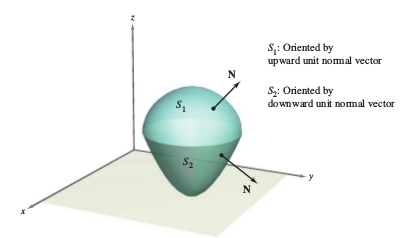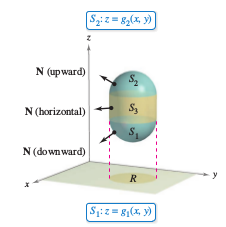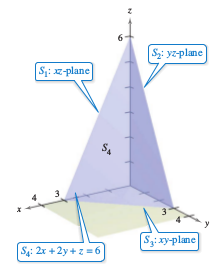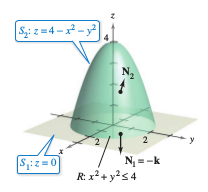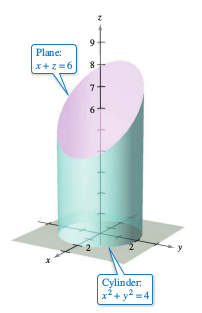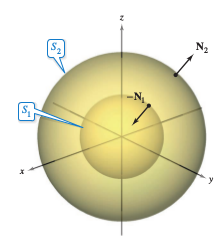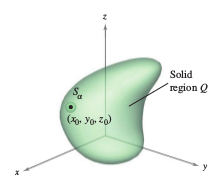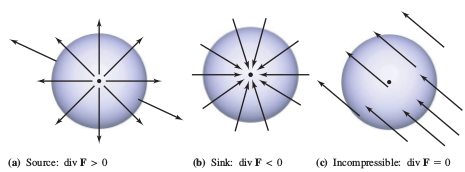Calculus III 15.07 Divergence Theorem
| Previous | Calculus III 15.06 Surface Integrals |
| Next | Calculus III 15.08 Stokes’s Theorem |
Contents
15.07 Divergence Theorem
- Understand and use the Divergence Theorem
- Use the Divergence Theorem to calculate flux
Divergence Theorem[1]
Also called Gauss’s Theorem and Ostrogradsky’s Theorem.
Recall from Section 15.4 a variant on Green’s Theorem[2]
| $$\int_{C} \textbf{F} \cdot \textbf{N} \:ds$$ | $$= \int_{R} \int \left(\frac{\partial M}{\partial x}+ \frac{\partial N}{\partial y} \right) \: dA $$ |
| $$= \int_{R} \int \text{div } \textbf{F} \: dA.$$ |
In an analogous way, the Divergence Theorem describes the relationship between a triple integral over a solid region \(Q\) and a surface integral over \(Q\)'s surface.
More precisely, the divergence theorem states that the outward flux for a vector field through a closed surface is equal to the volume integral for the divergence over the region inside the surface. Intuitively, it states that the all sources sum to (with sinks regarded as negative sources) the net flux from a region.
Theorem 15.7.1 Divergence
Let \(Q\) be a solid region bounded by a closed surface \(S\) oriented by a unit normal vector outward from \(Q\), as shown in Figure 15.7.1. If \( \textbf{F} \) is a vector field whose component functions have continuous first partial derivatives in \(Q\). Then
- $$\int_{S} \int \textbf{F} \cdot \textbf{N} \:dS= \int \int_{Q} \int \text{div} \: \textbf{F} \: dV.$$
|
|
Proof For \(\textbf{F}(x,y,z) = M\textbf{i} + N\textbf{j}+P\textbf{k} \), the theorem takes the form
Prove this by verifying that the following three equations are valid.
Because verifying these three equations is similar, only the third is discussed. Consider a simple solid region with upper surface
and
whose projections onto the \(xy\)-plane coincide and form the region \(R\). If \(Q\) has a lateral surface like \(S_{3}\) in Figure 15.7.2, then a normal vector is horizontal, which implies that \(P\textbf{k} \cdot \textbf{N}=0\). Therefore,
On the upper surface \(S_{2}\), the outward normal vector is upward, whereas on the lower surface \(S_{1}\), the outward normal vector is downward. Applying Theorem 15.7.1 produces
and
Adding these results produces,
|
Example 15.7.1 Using the Divergence Theorem
|
|
Let \(Q\) be the solid region bounded by the coordinate planes and the plane
and let \( \textbf{F}=x\textbf{i} +y^{2} \textbf{j} + z\textbf{k}\). Find
where \(S\) is the surface for \(Q\).
which yields
|
Example 15.7.2 Verifying the Divergence Theorem
|
|
Let \(Q\) be the solid region between the paraboloid
and the \(xy\)-plane, as shown in Figure 15.7.4. Verify the Divergence Theorem for
Solution The outward normal vector for the surface \(S_{1}\) is \(\textbf{N}_{1} = - \textbf{k}\). The outward normal vector for the surface \(S_{2}\) is
Applying Theorem 15.7.1 produces
Because
the Divergence Theorem can be applied to produce an equivalent result
|
Example 15.7.3 Using the Divergence Theorem on a Cylinder
|
|
Let \(Q\) be the solid bounded by the cylinder \(x^{2}+y^{2}=4\), the plane \(x+z=6\), and the \(xy\)-plane, a shown in Figure 15.7.5. Find
where \(S\) is the surface for \(Q\) and
Solution Evaluating the surface integral is complex. However, by applying the Divergence Theorem evaluating the integral reduces to this.
Notice in line 4 that cylindrical coordinates with
were used to evaluate the triple integral. |
|
|
The Divergence Theorem is also valid for regions that are the finite unions between simple solid regions. For example, let \(Q\) be the solid bounded by the closed surface \(S_{1}\) and \(S_{2}\), as shown in Figure 15.7.6. Let \(S=S_{1} \bigcup S_{2}\), then the normal vector \( \textbf{N} \) to \(S\) is given by \(-\textbf{N}_{1}\) on \(S_{1}\) and by \(\textbf{N}_{2}\) on \(S_{2}\). This produces
|
The Divergence Theorem and Flux
To understand the relationship between The Divergence Theorem and Flux consider each side in the equation below
- $$ \color{red}{\underbrace{\color{black}{\int_{S} \int \textbf{F} \cdot \textbf{N} \:dS}}_{\color{red}{\text{The Divergence Theorem}}}} = \color{red}{\underbrace{\color{black}{\int \int_{Q} \int \textbf{div} \: \textbf{F} \: dV}}_{\color{red}{\text{Flux}}}}.$$
The Flux integral on the right determines the total fluid flow across the surface \(S\) per time unit. This can be approximated by summing the fluid flow across small surface patches. The triple integral on the left measures this same fluid flow into, or out from, small cubes with volume \(\Delta \:V_{i} \). The Flux for the \(i\)th cube is approximately \( \text{div} \: \textbf{F}(x_{i},y_{i},z_{i}) \Delta V_{i}\) for some point \((x_{i},y_{i},z_{i})\) in the \(i\)th cube. Note that for a cube in \(Q\)'s interior, the fluid gain or loss through any one of its six sides is offset by a corresponding loss or gain through an adjacent cube's side. After summing over all the cubes in \(Q\), the only fluid flow that is not canceled by adjoining cubes is that on the outside cube edges on the boundary. Therefore the sum
- $$ \sum_{i=1}^{n} \text{div} \textbf{F}(x_{i},y_{i},z_{i}) \Delta V_{i} $$
approximates the total flux into or out from \(Q\), and therefore through the surface \(S\).
|
|
To see what is meant by the divergence for \( \textbf{F} \) at a point, let \( \Delta V_{\alpha}\) be the volume for a small sphere \(S_{\alpha}\) with radius \(\alpha\) and center \((x_{0},y_{0},z_{0})\) contained in region \(Q\), as shown in Figure 15.7.7. Applying the Divergence Theorem to \(S_{\alpha}\) produces
where \(Q_{\alpha}\) is \(S_{\alpha}\)'s interior. Therefore,
Taking the limit as \(\alpha \rightarrow 0\) yields the divergence for \( \textbf{F} \) at the point \((x_{0},y_{0},z_{0})\).
The point \((x_{0},y_{0},z_{0})\) in a vector field is classified as a source, a sink, or incompressible, as shown in the list below.
|
Example 15.7.4 Calculating Flux by the Divergence Theorem
Let \(Q\) be the region bounded by the sphere \(x^{2}+y^{2}+z^{2}=4\). Find the outward flux for the vector field \(\textbf{F}(x,y,z)= 2x^{3}\textbf{i} +2y^{3} \textbf{j} +2z^{3} \textbf{k} \) through the sphere.
Solution Applying the Divergence Theorem produces
| Flux across \(S\) | $$=\int_{S} \int \textbf{F} \cdot \textbf{N} \:dS $$ |
| $$= \int \int_{Q} \int \textbf{div} \: \textbf{F} \: dV$$ | |
| $$= \int \int_{Q} \int 6(x^{2}+y^{2}+z^{2}) \: dV $$ | |
| $$= 6 \int_{0}^{2} \int_{0}^{\pi} \int_{0}^{2 \pi} \rho^{4} \sin \:d\theta \: d \phi \: d \rho \:\:\:\: \color{red}{ \text{Spherical Coordinates}} $$ | |
| $$= 6 \int_{0}^{2} \int_{0}^{\pi} 2 \pi \rho^{4} \sin \:d\theta \: d \phi \: d \rho $$ | |
| $$= 12 \pi \int_{0}^{2} 2 \rho^{4} \: d \rho$$ | |
| $$=24\pi \left( \frac{32}{5}\right)= \frac{768\pi}{5}. $$ |
Internal Links
Parent Article: Calculus III 15 Vector Analysis
